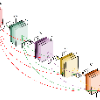Fabric is a planar material composed of textile fibers. Textile fibers are generated from many natural sources; including plants, animals, minerals, and even, it can be synthetic. A particular fabric may contain different types of fibers that pass through a complex production process. Fiber identification is usually carried out through chemical tests and microscopic tests. However, these testing processes are complicated as well as time-consuming. We propose FabricNet, a pioneering approach for the image-based textile fiber recognition system, which may have a revolutionary impact from individual to the industrial fiber recognition process. The FabricNet can recognize a large scale of fibers by only utilizing a surface image of fabric. The recognition system is constructed using a distinct category of class-based ensemble convolutional neural network (CNN) architecture. The experiment is conducted on recognizing 50 different types of textile fibers. This experiment includes a significantly large number of unique textile fibers than previous research endeavors to the best of our knowledge. We experiment with popular CNN architectures that include Inception, ResNet, VGG, MobileNet, DenseNet, and Xception. Finally, the experimental results demonstrate that FabricNet outperforms the state-of-the-art popular CNN architectures by reaching an accuracy of 84% and F1-score of 90%.
翻译:纤维是一种由纺织品纤维组成的平板材料。 纺织品纤维来自许多自然来源, 包括植物、 动物、 矿物, 甚至可以是合成的。 特殊纤维可能包含通过复杂生产过程的不同种类的纤维。 纤维识别通常通过化学测试和微粒测试进行。 然而, 这些测试过程既复杂又耗时。 我们提议FabricNet, 这是基于图像的纺织品纤维识别系统的先导方法, 它可能对个人产生革命性影响, 工业纤维识别过程。 FabricNet只能利用结构表面图像才能识别大比例的纤维。 识别系统是使用基于阶级的共振动神经网络(CNN)结构的不同类别来构建的。 实验是承认50种不同类型的纺织品纤维。 实验包括大量独特的纺织品纤维, 远超过我们以前为了解最佳情况而进行的研究。 我们与受欢迎的CNN结构进行了实验, 其中包括Incepion、 ResNet、 VGG、 MoveNet、 DenseNet、 DenseNet 和 Xcepie- grels 90- fristal 结构的实验结果。 最后, 显示Fart- fristal- frims- bal- fas- fasmal- fas- 的实验结果。




